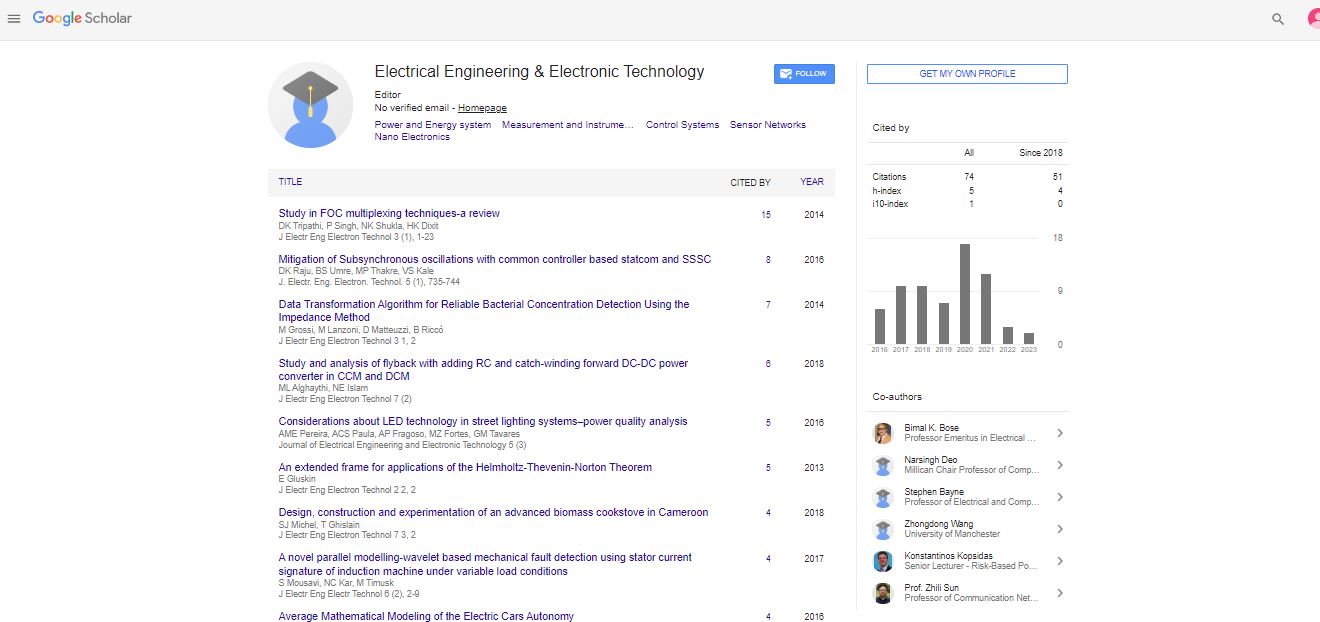Perspective, J Electr Eng Electron Technol Vol: 12 Issue: 1
Streamlining Data Processing with Multiplexers: Advantages and Applications in Digital Systems
Frederik Koch*
Department of Microelectronics, Delft University of Technology, Delft, Netherlands
*Corresponding Author: Martin Dahl
Department of Microelectronics, Delft
University of Technology, Delft, Netherlands
Tel: +316454287954
E-mail: fr.koch@tue.nl
Received date: 02 January, 2023, Manuscript No. JEEET-23-89693;
Editor assigned date: 04 January, 2023, PreQC No. JEEET-23-89693(PQ);
Reviewed date: 25 January, 2023, QC No. JEEET-23-89693;
Revised date: 02 ebruary, 2023, Manuscript No. JEEET-23-89693(R);
Published date: 09 ebruary, 2023, DOI: 10.4172/2325-9838.1000936
Citation: Koch F (2023) Streamlining Data Processing with Multiplexers: Advantages andApplications in Digital Systems. J Electr Eng Electron Technol 12:1
Description
A Multiplexer (also known as a mux) is a digital circuit that selects one of several input signals and forwards the selected input to a single output line. The selection is usually made by a set of control signals, which can be generated by a digital circuit or a computer.
Multiplexers are commonly used in digital circuits to reduce the number of wires needed to transmit data. For example, in a communication system, multiple signals (such as audio, video, and data) can be transmitted over a single wire by using a multiplexer at the transmitter and a demultiplexer at the receiver. In a microprocessor, a multiplexer can be used to select one of several sources (such as registers or memory locations) as the input to an arithmetic or logic unit.
A multiplexer can have two or more input lines and one output line. The number of input lines is typically a power of 2 (i.e., 2, 4, 8, etc.), and the number of control lines required to select the input line is equal to the logarithm (base 2) of the number of input lines. For example, a 4-input multiplexer requires 2 control lines, and an 8-input multiplexer requires 3 control lines.
Advantages of multiplexer
Reduced system complexity: Multiplexers allow multiple inputs to be selected and combined into a single output, reducing the overall complexity of the system.
More efficient use of resources: Multiplexers enable the selection of specific inputs or resources, allowing for more efficient use of hardware and resources.
Reduced wiring and signal routing: Multiplexers can reduce the number of wires needed to transmit data and signals, simplifying the signal routing and reducing costs.
Faster signal processing: Multiplexers can switch between different inputs or sources quickly, allowing for faster signal processing and response times.
Flexible design: Multiplexers enable a more flexible design, allowing for the selection of specific inputs or resources depending on the requirements of the system.
Lower power consumption: Multiplexers can reduce power consumption by enabling the selection of specific inputs or resources only when needed, reducing overall system power consumption.
Applications of multiplexer
Communication systems: In communication systems, a multiplexer is used to combine multiple signals (such as audio, video, and data) into a single data stream that can be transmitted over a single wire or wireless channel.
Digital circuit design: In digital circuits, multiplexers can be used to select one of several inputs to a logic gate or arithmetic unit. This allows for more flexible and efficient design of circuits.
Memory access: Multiplexers can be used to select one of several memory locations for read or write operations, allowing for more efficient access to memory.
Address decoding: In microprocessor systems, multiplexers can be used to decode memory or I/O addresses, enabling the selection of specific memory or I/O devices.
Test and measurement equipment: Multiplexers can be used in test and measurement equipment to switch between different input signals for analysis or processing.
Audio and video processing: In audio and video systems, multiplexers can be used to switch between different audio or video sources or to combine multiple audio or video signals.
Data acquisition systems: Multiplexers can be used in data acquisition systems to select one of several sensors or measurement inputs for processing.
Conclusion
In conclusion, a Multiplexer (mux) is a digital circuit that selects one of several input signals and forwards the selected input to a single output line. Multiplexers provide several advantages in digital circuit and system design, including reduced system complexity, more efficient use of resources, reduced wiring and signal routing, faster signal processing, flexible design, and lower power consumption.
 Spanish
Spanish  Chinese
Chinese  Russian
Russian  German
German  French
French  Japanese
Japanese  Portuguese
Portuguese  Hindi
Hindi 
